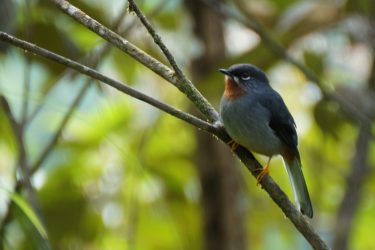In this series of blogs, Ed Drewitt freelance naturalist, broadcaster and wildlife detective highlights a different St Lucia bird each week. In this edition the St Lucia Pewee
By: Ed Drewitt
It took me a few attempts to finally see St Lucia Pewees and back on my first visit in 2012 I completely failed to see one, although I think I heard one call. The St Lucia pewee is a small flycatcher and as its name suggest, it can often be found flying out from a perch to catch insects, before often returning back to the same place. It is no bigger than a European Robin or a chickadee. Despite this it can be elusive at times as I have found from my own experience. The call is key though and if you learn that you have a much better chance of finding a pewee – see the link at the end of the blog to hear their calls.

The St Lucia pewee is an endemic subspecies of the Lesser Antillean pewee and is found here and nowhere else in the world. Like St Lucia’s other endemic birds such as the St Lucia oriole, warbler and parrot, the pewee has become isolated on the island, developing features over time through natural selection that are unique to it. In some books and webpages you may see it referred to as a complete species and the debate over its true identity continues.

Both male and female St Lucia pewees have peach-orange breasts and sandy-brown backs and wings. Their beak is ideal for catching insects. It is tweezer-like and broad at the base – if you watch a pewee flycatching you may hear its beak snapping as it catches something. Around the base of the beak there are long modified feathers that look like hairs. These help to protect the pewee’s eyes when hunting and guide the insect prey down into the mouth. They have large eyes in proportion to the size of their body which help them to hunt for insects in poor light under the forest canopy and during the low light of early morning and late evening. Their Latin name Contopus latirostris means short-footed and broad-beaked.

St Lucia pewees love being in the mountain forests although you will see them in smaller numbers at lower levels closer to the coast where it is drier and more open. Look out for them beneath the canopy layer, often low down swooping out in a small loop to catch small insects. On St Lucia they nest between May and June, building a small nest made out of leaves, lichen and moss and concealed on the outside with thin bark keeping the nest camouflaged from predators. Listen for their soft, quiet yet piercing ‘piew’ call and squeaky, chattering song, which is great way of knowing they are around – here are recordings to help you learn their calls.
Ed Drewitt is a freelance naturalist, broadcaster and wildlife detective
Learn More About Bird Watching at Anse Chastanet here

Anse Chastanet Resort

